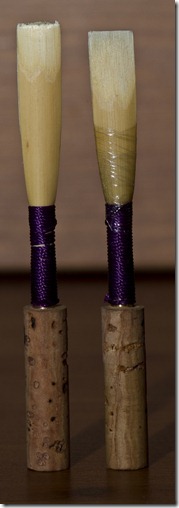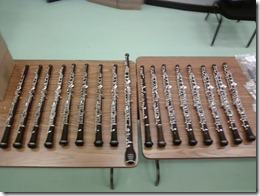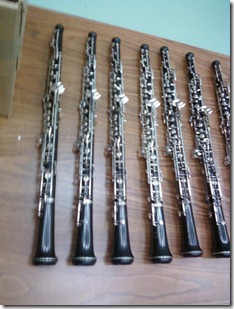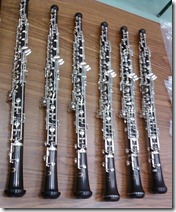 I was going to write about the master class for adults at the University of Ottawa Oboe Event, but then I made this experimental reed that deserves blogging! Actually, at the end of the master class, prof. Hamann (Chip), mentioned group lessons where everyone is expected to make a good reed in 15 minutes, so it still fits the bill. My account of the master class next time.
I was going to write about the master class for adults at the University of Ottawa Oboe Event, but then I made this experimental reed that deserves blogging! Actually, at the end of the master class, prof. Hamann (Chip), mentioned group lessons where everyone is expected to make a good reed in 15 minutes, so it still fits the bill. My account of the master class next time.
Experimenting with shapes and lengths
Following my blog and/or the BBoard, people know I like to experiment with shapes and stuff in the hopes of making an easier reed that sounds more “baroque-esque”. Well try this one on for size. But 1st, repeat: this is an experimental reed, so yes there are flaws with it, but there are also some really cool things about it.
Bad stuff, good stuff
The picture above shows (and the video below sounds) the reed and another blank just like it. Because this is an experimental reed, I’m not worried about these 3 flaws:
- it plays really flat (about 30 cents flat, so I guess A=435?)
- it is unstable in the usual 1st octave-key notes
- there is some buzz remaining in the sound
The buzz can be explained by the fact I spent only 5 minutes scraping it… more like 3, actually. The flatness and the instability can be explained by the measurements: it is 73.5mm in total length on a 45mm staple. This means it is very long cane compared to the norm, so stability might be better ensured with thicker cane than what I used (the usual 0.60mm). The shaper is also actually for oboe d’amore (Kunibert Michel 750), so really wide tip and really big belly. Finally, it is tied on Chiarugi #7 (really big … those of you who use Lorée staples would freak!).
But for the good part, if I can get the buzz out, this is starting to sound like my ideal. I’m curious to try this reed in a Marigaux: many people have stated that pretty much any reed will play with great stability. The dynamic range is great, it was really easy to scrape and the response is also great (with a rather thick tip). I’ll need to confirm if it still plays this well tomorrow, but here is what it sounds like: 3 minutes of scraping a freshly chopped blank!




